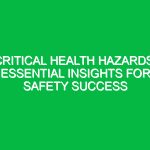Introduction
Biological Hazards, often referred to as biohazards, are organisms or substances produced by organisms that can pose a threat to human health and the Environment. In the realm of Health, Safety, and Environment (HSE), understanding these Hazards is crucial for implementing effective Safety protocols and ensuring Workplace Safety. This article explores various examples of biological hazards, discussing their significance in the HSE context, the associated risks, and Best Practices for management and Prevention.
The relevance of biological hazards cannot be overstated, especially in industries such as healthcare, agriculture, and food production. The potential for exposure to pathogens, allergens, and other hazardous biological agents necessitates rigorous Safety Measures. Employees, employers, and regulatory bodies must work collaboratively to mitigate these risks and safeguard public health.
Understanding Biological Hazards
Biological hazards can be categorized into several types, including bacteria, viruses, fungi, parasites, and allergens. Each of these categories presents unique challenges and requires specific Safety Measures. To illustrate, let’s consider a few examples that highlight the importance of addressing biological hazards within the HSE framework.
1. Bacterial Contamination in the Workplace
One of the most common biological hazards encountered in various workplaces is bacterial contamination. Bacteria such as *Escherichia coli* (E. coli), *Salmonella*, and *Listeria* can lead to severe foodborne illnesses. In environments like restaurants, food processing plants, and hospitals, proper hygiene practices are essential. Failure to maintain cleanliness can result in outbreaks that not only endanger employees but also customers and the general public.
Preventative Measures
To minimize the risk of bacterial contamination, organizations should implement strict hygiene protocols. These may include:
- Regular hand washing and sanitization stations
- Routine cleaning and disinfecting of surfaces
- Proper food storage and handling practices
- Training employees on food Safety Standards
Real-life incidents, such as the 2015 Chipotle Mexican Grill outbreaks, underscore the necessity of stringent food safety measures. Following these outbreaks, the company revamped its food preparation and safety protocols, demonstrating the importance of proactive risk management in preventing biological hazards.
2. Viral Infections in Healthcare Settings
Healthcare environments are particularly susceptible to viral infections, making them a significant biological hazard. Viruses such as influenza, norovirus, and the human immunodeficiency virus (HIV) can spread rapidly among patients and healthcare workers if not properly controlled.
Risk Management Strategies
To combat viral infections, healthcare facilities should adopt comprehensive infection Control Measures, including:
- Vaccination programs for staff and patients
- Use of Personal Protective Equipment (PPE)
- Isolation protocols for infected individuals
- Regular Training on infection prevention and control
An example of the impact of viral infections was observed during the COVID-19 pandemic, where hospitals faced unprecedented challenges. By implementing stringent infection Control Measures, many facilities managed to protect both patients and staff, showcasing the effectiveness of well-planned HSE strategies.
3. Fungal Hazards in Agriculture
In the agricultural sector, fungal hazards, particularly mycotoxins produced by mold, pose a serious risk. Crops such as grains and nuts can become contaminated, leading to health issues in livestock and humans who consume these products.
Understanding Mycotoxins
Mycotoxins are toxic compounds that can cause a variety of health Effects, including liver damage, immune system suppression, and cancer. Proper management of fungal contamination is essential to ensure food safety and public health.
Best Practices for Prevention
To reduce the risk of fungal hazards, agricultural workers and producers should:
- Implement crop rotation and proper storage techniques
- Monitor environmental conditions that promote mold growth
- Conduct regular testing for mycotoxins
- Educate workers on recognizing signs of contamination
The case of the 2004 aflatoxin contamination in corn, which affected thousands of livestock, highlights the need for vigilance and effective management within the agricultural sector.
Regulations and Standards Governing Biological Hazards
The management of biological hazards is not solely the responsibility of individual organizations; several Regulations and standards guide Best Practices in the HSE context.
Occupational Safety and Health Administration (OSHA)
In the United States, osha provides guidelines to protect workers from biological hazards. The Bloodborne Pathogens Standard, for example, outlines the necessary Precautions for employees who may be exposed to blood or other potentially infectious materials. Compliance with these regulations is crucial for safeguarding worker health in healthcare and laboratory settings.
Centers for Disease Control and Prevention (CDC)
The CDC offers extensive resources on infection prevention and control, particularly for healthcare facilities. Their guidelines emphasize the importance of hygiene practices, vaccination, and the use of PPE in mitigating the risks associated with biological hazards.
Environmental Protection Agency (EPA)
The EPA regulates the use of biocides and disinfectants, ensuring that these products are safe and effective for controlling biological hazards. Compliance with EPA regulations helps organizations manage risks while safeguarding public health and the environment.
Conclusion
Biological hazards present significant risks in various sectors, necessitating a proactive approach to health, safety, and environmental management. Understanding examples of biological hazards, such as bacterial contamination, viral infections, and fungal hazards, is essential for implementing effective safety protocols.
Through adherence to regulations, adoption of best practices, and continuous education, organizations can successfully mitigate the risks associated with biological hazards. The collaborative effort of employees, employers, and regulatory bodies is vital for promoting a safe and healthy work environment. As we move forward, it is imperative to remain vigilant and proactive in addressing these hazards to protect both human health and the environment.
By prioritizing biological hazard management, we can pave the way for safer workplaces and communities, fostering a culture of health and safety that Benefits everyone.


